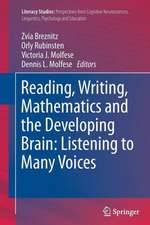Brain Research in Language: Literacy Studies, cartea 1
Editat de Zvia Breznitzen Limba Engleză Hardback – 13 dec 2007
Educators and researchers within neuroscience, literacy, and special education will benefit from Brain Research in Language.
| Toate formatele și edițiile | Preț | Express |
|---|---|---|
| Paperback (1) | 778.44 lei 6-8 săpt. | |
| Springer Us – 23 noi 2010 | 778.44 lei 6-8 săpt. | |
| Hardback (1) | 1100.85 lei 6-8 săpt. | |
| Springer Us – 13 dec 2007 | 1100.85 lei 6-8 săpt. |
Din seria Literacy Studies
- 18%
 Preț: 955.25 lei
Preț: 955.25 lei - 18%
 Preț: 968.65 lei
Preț: 968.65 lei - 15%
 Preț: 645.47 lei
Preț: 645.47 lei - 18%
 Preț: 886.40 lei
Preț: 886.40 lei - 15%
 Preț: 651.02 lei
Preț: 651.02 lei - 15%
 Preț: 640.88 lei
Preț: 640.88 lei - 18%
 Preț: 786.84 lei
Preț: 786.84 lei - 18%
 Preț: 954.45 lei
Preț: 954.45 lei - 15%
 Preț: 701.72 lei
Preț: 701.72 lei - 24%
 Preț: 802.76 lei
Preț: 802.76 lei - 15%
 Preț: 651.84 lei
Preț: 651.84 lei - 18%
 Preț: 890.68 lei
Preț: 890.68 lei - 18%
 Preț: 946.41 lei
Preț: 946.41 lei - 15%
 Preț: 638.57 lei
Preț: 638.57 lei - 18%
 Preț: 944.36 lei
Preț: 944.36 lei -
 Preț: 427.49 lei
Preț: 427.49 lei - 20%
 Preț: 620.46 lei
Preț: 620.46 lei - 18%
 Preț: 905.06 lei
Preț: 905.06 lei - 15%
 Preț: 635.65 lei
Preț: 635.65 lei - 15%
 Preț: 639.41 lei
Preț: 639.41 lei - 20%
 Preț: 564.52 lei
Preț: 564.52 lei - 15%
 Preț: 637.93 lei
Preț: 637.93 lei - 15%
 Preț: 654.12 lei
Preț: 654.12 lei
Preț: 1100.85 lei
Preț vechi: 1158.79 lei
-5% Nou
Puncte Express: 1651
Preț estimativ în valută:
210.67€ • 228.76$ • 176.96£
210.67€ • 228.76$ • 176.96£
Carte tipărită la comandă
Livrare economică 22 aprilie-06 mai
Preluare comenzi: 021 569.72.76
Specificații
ISBN-13: 9780387749792
ISBN-10: 0387749799
Pagini: 277
Ilustrații: VI, 277 p.
Dimensiuni: 155 x 235 x 18 mm
Greutate: 0.58 kg
Ediția:2008
Editura: Springer Us
Colecția Springer
Seria Literacy Studies
Locul publicării:New York, NY, United States
ISBN-10: 0387749799
Pagini: 277
Ilustrații: VI, 277 p.
Dimensiuni: 155 x 235 x 18 mm
Greutate: 0.58 kg
Ediția:2008
Editura: Springer Us
Colecția Springer
Seria Literacy Studies
Locul publicării:New York, NY, United States
Public țintă
ResearchCuprins
The Use of EEG-ERP in Written Language Research: A review.- Electrophysiological Correlates of Visual Word Recognition in the Hemispheres.- Mapping the Development of Coarse Visual Tuning for Print.- Auditory Mismatch Failure in Infants at Risk for Dyslexia.- The Relationship between Brainstem Dysfunction and the Development of Early Communication Skills in Premature Infants.- The Contribution of EEG-ERP Measures to Our Understanding of Brain Asynchrony in Dyslexia.- Dyslexia and the Failure in Forming Memory Traces.- Speech and Language Processing: How Special Is It?.- Electrical Revelations of Linguistic Knowledge and Expectations.- Brain Waves are Stethescopes: ERP Correlates of Novel Metaphor Comprehension.- Syntactic Processing in Two Languages and Bilingual Adult Readers: An ERP Study.- Rapid Serial Stimulus Presentation and ERP-Analysis, Including Source Localization, in the Frequency Domain.- Overlapping Tasks Methodology as a Tool for Investigating Language Perception.- The Correlation Based Model: An Alternative System for Analyzing ERP Data in Cognitive Research.- Connectivity-Coherence Analysis: Large Scale Neuronal Coordination in Reading: A Comparison between Regular and Dyslexic Readers.- Estimation of Electrical Brain Activity Sources During Lexical Decision Using LORETA: A Comparison of Dyslexic and Regular Readers.- Combining Event-Related Potentials and Eyes Movement in Reading Research.- An ERP Study Comparing German and English.- An ERP Study Comparing Hebrew and English.- An ERP Study comparing Russian, Hebrew and English.- An ERP Study Comparing Arabic and English.- The use of fMRI and ERP in Language Research: Time and Location.- Discussions and Conclusions.
Textul de pe ultima copertă
Brain Research in Language addresses important neurological issues involved in reading. The reading process is a highly composite cognitive task, which relies on brain systems that were originally devoted to other functions. The majority of studies in this area have implemented behavioral methodologies, which provide information concerning the entire cognitive sequence at the conclusion of processing only, in the reader’s output. However, these measures cannot specify all of the covert component operations that contribute to reading, nor can they determine the relative processing times required by the individual stages. Furthermore, they cannot determine which processes occur serially, which occur in parallel and which overlap in time (Brandeis & Lehmann, 1994; Johnson, 1995). Recent advancements in the field of neuroscience and cognitive development, however, have added a new dimension with regard to the research into the universal and domain specific aspects of reading with the advent of innovative neurophysiological measurement techniques. The most common are electroencephalography (EEG) and functional magnetic resonance imaging (fMRI). These two methods provide researchers with the opportunity to examine, in-depth, the neural correlates of the reading processing with precise temporal and spatial resolutions, respectively. This book presents data obtained from various studies employing behavioral, electrophysiological and imaging methodologies in different languages focusing on the regular reading process and the dyslexic population.
Educators and researchers within neuroscience, literacy, and special education will benefit from Brain Research in Language.
Educators and researchers within neuroscience, literacy, and special education will benefit from Brain Research in Language.
Caracteristici
Provides evidence of brain activity in terms of accurate time resolution Focuses on dyslexic as well as regular readers Provides evidence from numerous languages Provides a detailed review of existing methods in EEG research in written language Demonstrates the difference between these methods and other imaging techniques such as fMRI and MAG



















